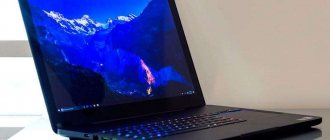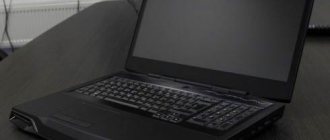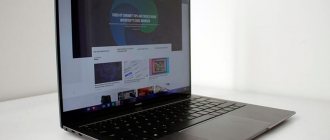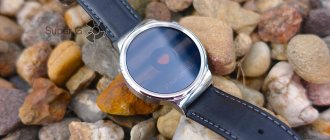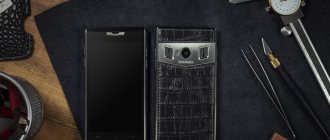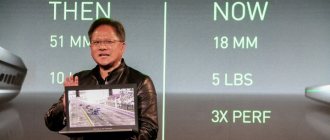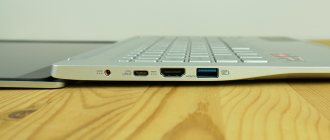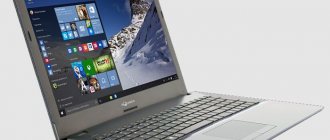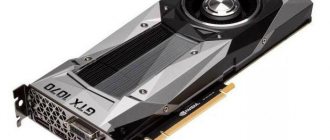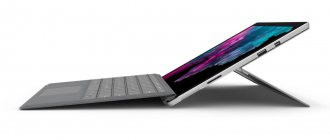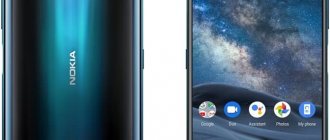This light and thin Windows laptop with an edge-to-edge screen has cross-platform compatibility with Android smartphones from the same manufacturer, allowing you to work with two devices simultaneously. The laptop's hardware includes a 4-core AMD Ryzen processor, a fast SSD PCIe drive, a basic set of interfaces, Dolby Atmos stereo speakers, a fingerprint scanner, and a battery with 65-watt charging. Vesti.Hi-tech found out all the pros and cons of Huawei MateBook D 14.
At the beginning of the year, Huawei announced the launch of a new series of ultra-light MateBook D laptops equipped with AMD Ryzen processors. We got a 14-inch model for testing, which, atypically, was slightly more expensive than the 15.6-inch. It turned out that it has an increased size of the SSD drive and a more capacious battery, although there is no accelerometer among the sensors. New laptop computers with a full-size keyboard complemented by a large touchpad have traditionally fallen to the share of office workers who willingly consume multimedia, but do not pretend to have complex graphics, including “heavy” games.
Huawei MateBook D 14 review: technical specifications
- Model: Nbl-WAQ9R
- Operating system: Windows 10 (version 1903, Home)
- Display: 14 inches, IPS, Full HD resolution (1920x1080 pixels, 16:9), dots per inch density 157 ppi, viewing angle 178 degrees, contrast 800:1, maximum brightness 250 nits, anti-glare coating
- Processor: Quad-core AMD Ryzen 5 3500U (2.1 GHz, max 3.7 GHz)
- Graphics: AMD Radeon Vega 8 (integrated)
- RAM: 8 GB, DDR4 (2400 MHz)
- Storage: PCIe SSD, 512 GB
- Wireless communications: Wi-Fi 802.11 a/b/g/n/ac (2.4 GHz + 5 GHz), 2x2 MIMO antenna, Bluetooth 5.0
- Interface connectors: HDMI (1), USB-A 2.0 (1), USB-A 3.0 (1), USB-C (1), 3.5 mm audio connector
- Sound: stereo speakers, Dolby Atmos Sound System, 2 microphones
- Camera: 1 megapixel sensor (720p HD)
- Sensors: Hall sensors and fingerprint sensor
- Battery: Li-polymer, 56 Wh (3,665 mAh, 15.28 V), 65-watt adapter
- Dimensions: 214.8×322.5×15.9 mm
- Weight: 1.38 kg
- Color: space gray
Screen
The viewing angle of the screen is 178 degrees. Lying on the sofa with a laptop on your lap, in public transport with the display at an acute angle - in almost any use scenario the color rendition will not be distorted.
The screen aspect ratio is 16:9, resolution is Full HD. Classic indicators. The disadvantage of the screen is the pixel density. Here it is 167 ppi. For comparison, the MacBook Pro 16 has 226 ppi. This makes the picture appear less clear and you can see grain on the screen.
Display brightness is 250 nits. Acceptable indicator. On a clear day, you won’t have to squint and cover the display with your hand from the rays of light, and in a dark room, at a low setting, the screen won’t hit your eyes. Contrast - 800:1.
The default colors are warm. The vision protection mode is supported, with which ultraviolet radiation is reduced to a minimum. It is advisable to use it in low light conditions or when working with text.
The frame is the thinnest. The widest edge is the bottom, where the logo is located. The rest are symmetrical. Their thickness is only 4.8 mm, they are almost invisible.
Huawei MateBook D 14 review: design
The laptop body is made of aluminum alloy, finished in Space Gray, and looks sleek and compact.
To the untrained, “earthly” eye, the color has a lilac tint. Well, the laptop lid is predictably decorated with the manufacturer’s logo - Huawei.
The weight of MateBook D 14 does not exceed 1.38 kg,
and the thickness of the case is 15.9 mm.
At the same time, a 14-inch screen was fitted into the dimensions 214.8x322.5 mm. The frames around the display, which occupies 84% of the inner surface of the lid, are made of rough, painted plastic, the width of three of them is no more than 4.8 mm. It is this fact that allows us to call the laptop screen “frameless”. Note that the lid tilts at an angle of 180 degrees, so a user with a laptop can take almost any position convenient for themselves.
On the bottom panel of the case, in addition to three rubber “feet” for a stable position of the laptop on a flat surface, there are decorative grilles for stereo speakers and ventilation holes. Underneath the latter is a cooling system that includes a low-noise Shark Fin 2.0 fan with S-shaped blades.
The system dynamically optimizes airflow and heat dissipation, keeping the processor cool even during demanding tasks.
The working surface of the case, where the keyboard and touchpad are located, is practically the same color as the lid.
In the upper right corner is the power button.
It has a built-in fingerprint sensor for easy identification when logging in.
On the edge next to the touchpad there is a special recess for convenient opening of the cover, where there are holes for two microphones.
By the way, it is almost impossible to open the lid with one hand.
But in any position it is fixed quite rigidly.
On the left edge of the case, USB-C connectors for connecting an external device or power adapter, an LED charging indicator, a high-speed USB-A 3.0 port and an HDMI multimedia port were collected together.
On the right edge there is a USB-A 2.0 connector and a 3.5 mm connector (“mini-jack”). Unfortunately, there is no card reader or holes for a Kensington lock.
⇡#Matebook X
At the same time, the most interesting and the most literally copied model from its competitors - the Matebook X does not even try to pretend that it does not want to be like a MacBook: there is a design recognizable at first glance, and even the absence of a touch screen (obligatory, it would seem, for compact laptops on Windows). In this case, this is not bad - there is a shortage of good compact laptops on the market without unnecessary bells and whistles. But thin and powerful enough – there will always be an audience for such gadgets.
The Matebook X throws some impressive numbers in your face right off the bat. Thickness - 12.5 mm! Weight – 1.05 kg! 13-inch display with 2K resolution (2160 × 1440)! Full-fledged Intel Core i5 or i7 (Kaby Lake) with passive cooling! But “Mr. X” gets its start not primarily from its characteristics, but from the impression it makes.
Metal, glass, extreme thinness and no originality, but it looks beautiful and is very well executed. Colors: gold and silver, of course, as well as pink – the Matebook X also manages to look great in this color. This is probably the cutest pink laptop I've ever seen. In 2020, when thin laptops running Windows have become not so easy to find, this is a real balm for the soul. Which, of course, is diluted not even with a drop of tar, but with whole glasses of tears about the price. From 1,399 to 1,699 euros! Harsh.
For this money, however, you get not only a laptop, but also (surprise!) a docking station-adapter from USB Type-C to USB Type-A, VGA and HDMI. After all, the thin case has nothing but two (and still, learn, Apple!) USB Type-C and one mini-jack.
Matebook X is the first thin laptop with Dolby Atmos on board. There are two speakers built into the top panel, above the full-size keyboard. And on the side of them is a power button with a built-in fingerprint scanner. Where would we be without him?
Power is provided by a 41.4 Wh battery. It should be enough for 10 hours of video playback at half the display brightness (regardless of the version). Built-in graphics, 256 or 512 GB SSD and 4 or 8 GB RAM depending on the version (WT-W09 or WT-W19).
This is perhaps the most important of today's three announcements - Huawei has devoted significantly more time to it than the other two. But, judging by the price, the Chinese need it for image purposes - “Look how we can do it!” A statement that Huawei is entering the laptop market in earnest. Well, we believe it is a really great gadget.
Huawei MateBook D 14 review: ports, touchpad, keyboard
The number of external wired interfaces on the MateBook D 14 is limited. There are only three USB ports, represented by a USB-C connector, as well as two USB-A, supporting USB 3.0 (up to 5 Gbps) and USB 2.0 (up to 480 Mbps) specifications, respectively. Unfortunately, the plastic for USB 3.0 is not only not marked in blue, but there is also no graphic designation of this high-speed port. A full-size HDMI connector (type A) is provided for connecting an external monitor. There is a 3.5 mm connector for an audio headset or headphones.
The full-size island-type membrane keyboard has backlit keys. As usual for laptops, the top row of service buttons (brightness, volume, microphone, Wi-Fi...) is combined with functional buttons F1-F12, the latter working in combination with the Fn key. So, one of the buttons (F3) in the row of functional ones is designed to turn on, turn off and increase the brightness of the backlight. It must be said that even with increased brightness, the backlight is quite weak, and during the day it is practically not visible at all. White symbols on a black background of keys, however, are clearly visible.
The keyboard does not have any protection against water. The drainage hole on the bottom of the body (in the middle of the long "leg") should not be misleading, since, according to the manufacturer, it is only intended to remove a small amount of water from the camera.
By the way, the camera in this laptop was hidden in a row of function keys (between F6 and F7) in the center.
After pressing the corresponding button, the lens will open, which will close after pressing again. So, privacy violations or data leaks through the camera are now virtually impossible.
The elongated touchpad turned out to be large and convenient - its dimensions are approximately 65x122 cm. Both control keys are hidden under the touch panel, which recognizes not only 2- and 3-point gestures (taps and swipes), but also 4-point touches. The cursor positioning when moving quickly is relatively accurate, so working with the touchpad is quite convenient. By the way, in the default Windows 10 settings there is an option that does not disable the touchpad even when working with the mouse.
To the right of the touchpad there is an NFC tag called Huawei Share. More about her below.
Huawei MateBook D 14 review: screen
For the new laptop, we chose a 14-inch screen based on an IPS matrix from BOE (Beijing Orient Electronics) Technology Group. With a maximum resolution of 1920x1080 pixels (16:9 aspect ratio), the pixel density per inch on this display is 157 ppi. Wide viewing angles vertically and horizontally reaching 178 degrees. The manufacturer claims a contrast ratio of 800:1 and a maximum brightness of 250 nits, which is typical for a device of this class. So you can comfortably use a laptop outdoors during the day only by shielding yourself from direct sunlight.
The laptop's settings include a TÜV Rheinland-certified eye protection mode that reduces the amount of blue light in the spectrum, especially at night. The color temperature of the screen, when the display acquires a “warm” yellowish tint, can be manually selected at your discretion. At the same time, the activation of the “night light” can be easily scheduled, either at specific hours, or, after determining your location, from sunset to dawn.
Ergonomics and design
According to the manufacturer, the laptop body is made entirely of metal, in general this is true, with the only exceptions being the display frames and the lower removable panel. Unfortunately, the coating on the case is quite easily soiled and quickly collects smudges and fingerprints. In general, the design is quite ascetic; the only decoration is the Huawei logo on the top cover. The hinges holding the screen hold it quite well, so the laptop cannot be opened with one hand; the maximum opening angle is approximately 130 degrees. The build quality is quite good, all parts of the case fit tightly together, there are no gaps or irregularities.
As for the ports, there are not so many of them, most of them are located on the left side of the case, one USB 3.1 Gen1 Type-C (also used to connect power), HDMI and another USB 3.0. On the right is a headphone/microphone combo jack and USB 2.0. The dimensions of Huawei MateBook D 14 - W00D are quite comfortable - 16 x 323 x 221 mm. It is worth understanding that this device is not positioned by the manufacturer as an ultrabook, however, the weight is only 1.47 kg. Which is quite good for a laptop with a 14-inch matrix. This model does not have a service cover for quick access to, for example, RAM and SSD, so to get to the insides you need to remove the entire bottom cover, which is held in place by nine bolts.
Keyboard and touchpad
The laptop has a full-size keyboard, with two-level backlighting and without a separate number pad. The keys themselves are large and flat with clearly visible characters. The key travel is too short, but the feedback is clear. The top row is equipped with function buttons that work in conjunction with the Fn button. To the right of the keyboard at the top is a round power button. The large touchpad, with a laser-treated surface measuring 6.5x10.5 cm, which functionally completely replaces the mouse manipulator, also deserves kind words. Built-in keys: short travel and crisp response.
Display and sound
The laptop display is based on a 14-inch matte IPS matrix from BOE (Beijing Orient Electronics) Technology Group, the aspect ratio is standard 16:9, the pixel density is 171 ppi, and the resolution is 1920x1080 pixels. The maximum brightness of the matrix is 295 nits, and the average is 278 nits, backlight uniformity is 86%. Pulse width modulation (PWM), unfortunately, is used to adjust brightness. The contrast is quite high at 1150:1, so the colors on the screen look sharp. Unfortunately, the display cannot please you with its color gamut; we received only 64.3% sRGB. Overall, the display has excellent colors, a clear display and as a result makes a good impression. The sound subsystem of the laptop consists of two speakers, which have an average volume reserve. The speakers work well in the high and mid frequency range, which is suitable for watching movies, but music lovers will have to connect headphones.
Review of Huawei MateBook D 14: filling
The tested laptop has an AMD Ryzen 5 3500U processor. Designed to 12 nm design standards, this chip includes four computing cores that can simultaneously process eight threads. The operating frequency, which is 2.1 GHz, increases to 3.7 GHz in overclocking mode. The TDP (Thermal Design Power) heat dissipation requirements, which indicate how much thermal power a processor cooling system should be designed to dissipate, were set to 15 W. The built-in 2-channel controller supports high-speed DDR4-2400 memory. Thus, in the tested configuration, the laptop carried 8 GB of DDR4-2400 RAM manufactured by Samsung.
The processor has a built-in AMD Radeon Vega 8 graphics accelerator with support for DirectX 12, OpenGL 4.6, Open CL 2.0 and Vulkan 1.0. It is believed that in terms of performance it ranks between the GeForce 940MX/Radeon Pro 450 and the GeForce MX150/Radeon Pro 555. This accelerator is well suited for simple office work and simple multimedia tasks.
Based on the results of the multi-platform benchmark GeekBench 5.1.0, we can say that there will definitely be no problems with office software, a browser, a multimedia player, etc., as well as games that are not demanding on the graphics subsystem.
A countdown on the gaming “line” - the 3DMark benchmark - showed that due to the lack of a serious graphics coprocessor, this laptop model is not intended for “heavy” games.
The data storage subsystem of the MateBook D 14, based on a solid-state drive, does without a hard drive. Thus, this model has an SSD from Western Digital – WDC PC SN730 with a capacity of 512 GB and a PCIe x4 interface.
The ATTO Disk Benchmark utility determined the maximum speeds for sequential read and write to be approximately 2.5 GB/s. These are very good indicators.
The CrystalDiskMark test results for this case look even more optimistic.
The laptop's wireless communication capabilities are determined by the presence of a Wi-Fi 802.11 a/b/g/n/ac interface module (2.4 GHz + 5 GHz) with 2x2 MIMO antennas, as well as a Bluetooth 5.1 interface.
The camera with a 1-megapixel sensor is intended mainly for video communication. However, in combination with the standard Camera application, you can also take video selfies in [email protected] or take self-portraits with a resolution of 1280x720 pixels.
The audio system with stereo speakers is designed to provide surround sound. Let us remember that both emitters are located on the bottom panel of the case, while the relatively high “legs” prevent the decorative grilles from closing on a flat surface. In turn, Dolby Atmos technology offers several profiles, including those with smart equalizers.
Ecosystem
To the right of the touchpad is NFC. Relax, you don’t need to pay for your purchases with a laptop. Huawei Share OneHop technology works using NFC; in conjunction with the company’s smartphone, you will get a full-fledged ecosystem.
What you can do with this technology:
- Instantly exchange data between your smartphone and Huawei laptop
- share clipboard contents: copy text on a smartphone and paste on a laptop
- display a smartphone screen on a laptop display
- control your smartphone using a laptop - for example, scroll through desktop pages or open applications using a computer mouse.
Data is transmitted over Wi-Fi and Bluetooth networks. Setting up a connection between devices is extremely easy - launch the PC Manager application on your laptop, and make sure NFC is activated on your smartphone. Place your phone near the NFC area on your laptop and you'll instantly execute any of the above commands.
We tested the technology on a combination of a MateBook D14 laptop and a Mate 30 Pro smartphone with the latest version of Huawei Share OneHop. File transfer is lightning fast. We will tell you about our impressions in a separate article.
Huawei MateBook D 14 review: autonomy
The capacity of the built-in battery in the MateBook D 14 is 56 Wh, which corresponds to 3,665 mAh @ 15.28 V. The laptop includes a 65-watt USB PD adapter with maximum output parameters - voltage 20 V and current 3.25 A. By the way, it is easy to charge a smartphone from the same adapter (5 V/2 A, 9 V/2 A, 12 V/2 A). In normal mode, the laptop battery can be filled by about 46% in just half an hour. According to the manufacturer, one battery charge is enough for 9.5 hours of watching video in 1080p quality with a brightness of 150 nits. But playing a set of our test videos in MP4 format (hardware decoding) and FHD quality at full brightness every hour reduced the battery charge by about 13.6%. So, with such a load, the battery charge will last for the entire working day.
Along with the standard “Battery” icon in the Windows 10 interface, there is a tiny LED on the MateBook D next to the USB-C power connector, which, notifying you of charging, slowly blinks white, and lights up constantly when the battery is full.
Autonomy, battery
The Huawei MateBook D laptop has a built-in 43 Wh battery. According to the manufacturer itself, the battery should last for 7 hours of video, up to 5 hours of office work and surfing the Internet.
In practice, with looped video playback at 50% screen brightness, the laptop worked for 6 hours and 50 minutes. With brightness increased to 100%, the time was reduced to 5 hours 15 minutes. With a mixed usage profile at 50% brightness, the MateBook D shows a result of about 5 hours of continuous operation. This result is average, but quite good for its class.
The laptop comes with a charger with a proprietary 19V and 3.42A power connector. The cable length is 1.85 m. The mains charger allows you to charge the laptop up to 60% in 1 hour, and up to 100% in 2 hours.
Huawei MateBook D 14 review: software features
The laptop runs the Windows 10 operating system (version 1903, Home).
Windows Hello makes authentication much faster and more convenient than using a password. To activate it, go to “Settings”>”Accounts”>”Login Options”. Once your fingerprint is registered, the power button with built-in fingerprint scanner from Goodix can be used to quickly and securely start and unlock your computer without entering a password.
The pre-installed proprietary PC Manager application allows you to quickly update drivers and monitor the status of your computer hardware.
In addition, using this application, it is convenient to connect a smartphone under the same brand (Huawei/Honor) to a laptop, and the interaction will be especially close with devices with the latest system software.
Let us recall that two years ago Huawei introduced OneHop technology, which allows you to quickly transfer files between smartphones and a computer, including photos and videos. This solution has significantly changed the approach to transferring files between Windows and Android devices, simplifying cross-platform connection. The new MateBook D laptops now feature the Huawei Share (OneHop) sharing feature, which also includes support for “multi-screen” (once connected, the content of the smartphone display is automatically displayed on the large screen of the laptop).
This option makes it even easier to connect a smartphone to a laptop using the NFC interface, when you just need to touch the smartphone to the above-mentioned Huawei Share NFC tag on the laptop.
After such a connection, the user has access to direct file transfer via Wi-Fi and Bluetooth, as well as control of smartphone applications with the mouse or touchpad of a laptop.
The mechanism for transferring photos, videos, documents and music tracks from a smartphone to a laptop and back is simple and convenient.
It is worth repeating that the full set of functions is not available for all smartphones under the Huawei/Honor brand - the proprietary EMUI 10 or Magic UI 3.0 shell is required. In addition, at the moment, for example, the OneHop screen recording function is implemented only for computers based on Intel processors.
Equipment and prices
Huawei MateBook D 14 is equipped with eighth-generation Intel i5-8250U or Intel i7-8550U processors, and there is also a model with an AMD Ryzen 5 2500U processor. The laptop runs on the Windows 10 operating system. The amount of RAM can range from 4 to 8 GB LPDDR3 standard. Integrated solutions from Intel or AMD act as a graphics accelerator; there is also a model with a discrete Nvidia GeForce MX150 video card.
Data storage is carried out on:
- M.2 SSDs up to 256GB
- M.2 SSDs up to 512GB
The resolution of the 14-inch screen is 1920x1080 pixels, the matrices are made using IPS technology and have a matte finish. The price of Huawei MateBook D 14 starts from 49,000 rubles.
